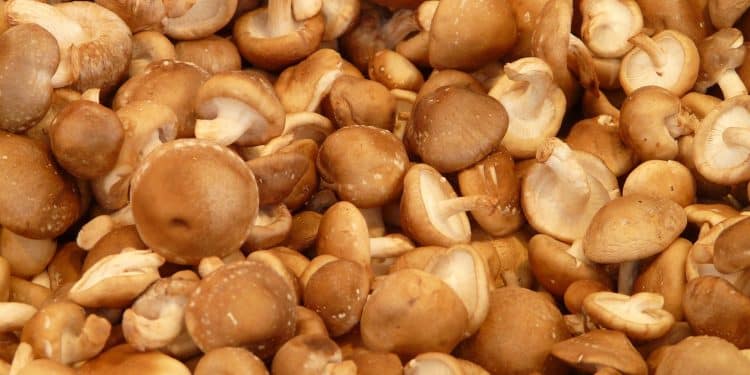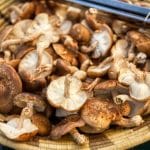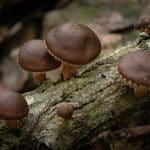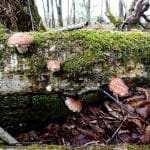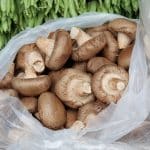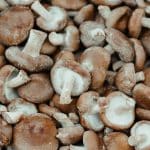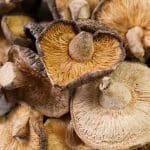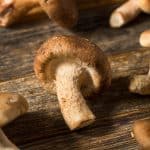Portobello mushrooms, originating in Europe and North America, are large, meaty mushrooms that are commonly used as steak or hamburger replacements. They are the matured form of the more commonly seen white mushrooms, or crimini. Shiitake mushrooms, which are rich in iron and have smoky flavors, are native to Asia, with a round cap with a darker underside. Although Shiitakes and Portobello mushrooms are commonly used in cooking, they vary in taste, texture, size, and price.
| Portobello Mushroom | Shiitake Mushroom | |
|---|---|---|
| Introduction | Portobello, an edible mushroom, is the mature form of button mushroom when white and crimini mushroom when brown, native to grasslands in Europe and North America. | The Shiitake mushroom is an edible mushroom native to East Asia, cultivated and consumed in many Asian countries. |
| Origin | Europe as well as North America. | East Asia |
| Texture | Meaty/chewy | Soft, fleshy |
| Flavor | Neutral | Smoky, woody |
| Size | Larger | Medium |
| Common recipes | Sandwiches; main course in Italian dishes with pasta | Asian stir fries; miso soup; dashi |
| Price | $4-$6 per pound | $13-$15 per pound |
| Calories | 22-29 per 100 grams | 34 per 100 grams |
| Vegetarian? | Yes | Yes |
| Vegan? | Yes | Yes |
| Scientific name | Agaricus bisporus | Lentinula edodes |
Origins or Portobello and Shiitake Mushrooms
Portobello mushrooms are found in grasslands in Europe and North America, and Shiitake mushrooms are found in eastern Asia. Both types of mushrooms are grown wild, but are also farmed for food, and, in the case of shiitake mushrooms, for their medicinal benefits.
You can find our favorite supplements containing Shiitake Mushrooms on the following page of our website to learn more.
Nutrition and Health Benefits of Each Mushroom
One of the main differences between the two types of mushrooms is the nutrition content. While portobello mushrooms are high in iron, potassium, and vitamin D, nobody rates them quite as high in health as Shiitake varieties.
Shiitake mushrooms are coveted by cultures all over the world for their health benefits, including protection against heart disease. Shiitake promoters claim that eating these mushrooms can prevent heart disease by lowering levels of bad cholesterol.
In addition, animal tests show a compound found in shiitake called lentinin has anti-cancer and immune-boosting benefits. In human studies, lentinin has been shown to have benefits for prolonging life of patients suffering from stomach and colon cancer.
Flavor and texture of Portobello and Shiitake
If you had vegetarians over for dinner, particularly at a BBQ, chances are that you would grill up Portobello Caps as your main dish. That is because a cooked Portobello has a dense, nearly meaty texture; these mushrooms also absorb lots of liquid, making them perfect for barbecue sauce or marinaded in a teriyaki marinade. The caps are large, too, usually about 5-inches across.
Portobellos are commonly used as steak replacements on hamburgers, as well as a vegetarian alternative. Shiitake mushrooms are frequently used in Asian cooking, particularly Chinese and Japanese. Shiitake mushrooms are also a bit meaty, adding flavors that are usually described as woody or smoky.
Availability of Each Mushroom
Portobello mushrooms are a member of the same family of mushrooms, like the White Button and Cremini varieties (among others), that are common throughout North America. Because of this, they are likely to be fresher at your local supermarket more frequently than native Asian Shiitake varieties. You might find shiitake mushrooms sold dried in plastic packaging. It is easy to rehydrate mushrooms by submerging in hot water.
Etymology of Portobello and Shiitake Mushrooms
According to legend, Portobello got its name in the 1980s, in a marketing push to glamourize, and therefore market, a mushroom that was frequently dismissed. Portobello mushrooms are the matured form of the Agaricus bisporus, the ubiquitous mushroom known by many names, button mushrooms, white mushrooms, cultured mushrooms, tagliatelle mushrooms, Champignon mushrooms when white, and Swiss brown mushrooms, Roman brown mushrooms, Italian browns, Italian mushrooms, cremini/crimini mushrooms, brown caps mushrooms, chestnut mushrooms when brown.
The word shiitake is Japanese, from comb words for the trees (Shii) and mushrooms (take). Shiitake mushrooms grow on trees or stumps. The scientific name for the shiitake mushroom is Lentinula edode.
Learn more:
